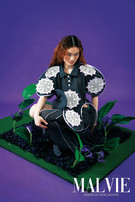
Can you tell us about your journey as a fashion designer, and how your upbringing in China has influenced your creative process?
Growing up in Shanghai China, the idea of unity accompanied my whole education system. In the long long history of China, it has developed a very strong cultural awareness near my surrounding environment and people. I was always aware of not being too different from others, so that it would not break the idea of unity, but it also created limitations to my creativity. If my creative journey is a painting, China must be the base palette. My journey abroad in Singapore and the US are the creative progress that developed and grew from the base.
What inspired your design philosophy of bringing order to chaos, and how does it manifest in your collections?
Bring order to chaos is the idea that came from my perfectionist nature. I am always seeking something different and something in disorder, so I can organize them and reconstruct them into new but familiar objects. My creative process often begins with massive and messy research. I enjoy cleaning and organizing these ideas. I am always excited to see unexpected transformation of details into new results.
Your focus on ordinary objects and multi-functionality is intriguing. Could you share some examples of how you've incorporated these elements into your designs?
I like to find inspiration from my surroundings. It could be a sound, an object, a memory or a person. I would expand the inspiration and relate it to the dysfunctionality of the environment, creating new formulas or giving solutions to problems.
How do you approach the use of unconventional materials in your creative process, and what role do they play in your designs?
Breaking traditional concepts is part of my design passion. Unconventional materials are very good media as well as the breaking point of traditional ideas. Using objects and textures that people are unfamiliar with, often brings surprises to the process. For example the combination of plaid and sports jersey contrasts the traditional use of business plaid textures.
The Birdie collection is described as representing achieving more with less. Can you elaborate on the concept behind it and how it ties into your personal experiences and inspirations?
It's like playing golf and getting to the green with fewer shots, symbolizing efficiency and excellence. ‘BIRDIE’ is a golf terminology for a score of one-under-par. That simply means you are on the green in fewer shots than it takes to finish 18 holes. For golfers, it is a wonderful moment to get a ‘Birdie’ shot. Birdie is not all about luck, it also represents the amount of practice behind the luck. Same with my design outcome, they are the fruit of my experiments and research. I try to condense all the research into the best visual effect possible.
What inspired you to use golf as a theme for the Birdie collection, and how does it relate to your relationship with your father?
My dad is the muse of this collection.He is a businessman and also a golfer. Being born in a business family, golf has been a necessity for my education. Golf is known for a businessman sport, but its age and gender free quality is what inspired me. I wanted to portray golf in a different and unconventional way while expressing the playful time I have with my dad through the sport, golf.

Could you discuss your use of purple, natural wool, and sports jerseys in the Birdie collection, and the significance behind these choices?
I chose purple as the main tone of this collection, the main reason is to contrast with the green grass on the golf course. I believe this color will stand out the most on the course. Purple has also been a gentleman color since ancient China. It represents noble, wealth and intelligence. In the modern timeless, the color purple is associated with magic, creativity and fantasy. I also want to create a dreamy story, giving my audience a brand new purple golf world. In the old times, gentlemen who played golf often wore wool suits. Nowadays, everyone wears sports jersey material to the golf course. I aimed to combine past and present to form a balanced futuristic picture.
Your experimentation with forms, tailoring, and 3D printing techniques is innovative. How do these techniques contribute to the overall aesthetic and concept of the collection?
I extracted forms from ‘CHUIWAN’, which is an ancient Chinese sport that is similar to modern golf. Tailoring, and 3D printing were only a small part of my experimentation. Felting, embroidery, and piping were also important techniques used in my research as well as the final garments. By integrating traditional crafts and unconventional technology, I was able to clearly articulate the golf fantasy in my mind.
Can you walk us through the process of transforming standard polo shirts into the playful printed polo dresses featured in the Birdie collection?
Polo shirt is also a very common uniform of Golf. It is the most straightforward way of showing differences between the old and new golf. The prints are mostly inspired by the silhouette of ancient Chinese golf balls, the swinging motion of a golf club, and the business element of plaid. Instead of the classic polo shirt, I played around with the shape and transformed it to polo dresses with open back, giving a more playful and modern element to the classic polos.
The integration of piping from golf bags into garment design is a unique touch. What inspired this choice, and how does it reflect your transformative approach to fashion?
Golf bags are the icon of golf. I am always intrigued with the construction and shape of the bags, especially the materials of the vintage golf bags. Therefore I deconstructed several vintage and modern gold bags, and reconstructed them into silhouette research in each garment.
Finally, what message or experience do you hope to convey to your audience through your Birdie collection, and what do you envision for the future of your brand?
I aim to create a space for my audience to pause, breathe, and immerse themselves in my work for a moment, away from the distractions of their busy lives. I hope everyone can develop a deeper appreciation for the small moments and things near their surroundings. Jenny Xiao will continue to bring surprises and fresh ideas in the future.

Model: Josh Denton @joshi_deee
Fashion Designer: Jenny Xiao @jennyxiao.u
Photographer: Grace Lu @grace.lux
Makeup Artist: Jian Lu @jianlumakeup
Model: Ella Guo @ellaguooo
Hair Stylist: April Andreu @april.andreu
























What were the specific limitations to creativity that you encountered while adhering to the idea of unity in your educational background in China?